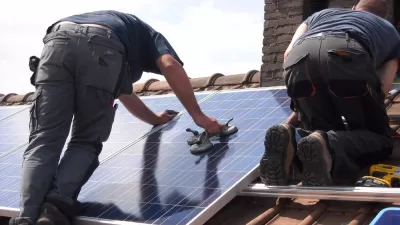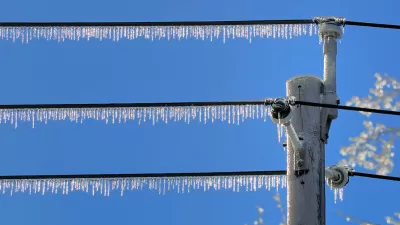One of solar’s biggest challenges is getting the energy where it needs to go.

The solar energy industry is growing by leaps and bounds as local utilities and companies that operate energy-guzzling data centers seek out renewable energy sources, report Spencer Kimball and Gabriel Cortés for CNBC.
“But renewables face a massive bottleneck to get connected to the grid, and building out transmission lines to support the growth poses a big challenge,” the authors add. Renewable energy sources remain just 3.9 percent of the nation’s power mix in 2023, and the nation’s aging power infrastructure is struggling to keep up with demand, which is growing in part due to the growth of data centers as well as rising temperatures and growing populations.
While “Nearly 2,500 gigawatts of solar, wind and battery projects were requesting connection in 2023, almost double the entire installed capacity of the current U.S. power plant fleet,” one analyst notes that “The rate by which renewables are deployed would need to at least triple to achieve 90% clean electricity over the next decade.” Plants that came online in 2023 took roughly five years to complete, and just 20 percent of projects with applications submitted between 2000 and 2018 were completed.
But solar is making significant gains, too. “In California, for example, solar energy represented more than 50% of the state's power supply from 7:45 a.m. until 5:25 p.m., peaking at about 18 gigawatts or 64% of supply around 1 p.m., according to Grid Status, which tracks major U.S. grids in real time.”
FULL STORY: Solar is growing faster than any electricity source as Big Tech seeks clean energy for data centers

Alabama: Trump Terminates Settlements for Black Communities Harmed By Raw Sewage
Trump deemed the landmark civil rights agreement “illegal DEI and environmental justice policy.”

Planetizen Federal Action Tracker
A weekly monitor of how Trump’s orders and actions are impacting planners and planning in America.

Why Should We Subsidize Public Transportation?
Many public transit agencies face financial stress due to rising costs, declining fare revenue, and declining subsidies. Transit advocates must provide a strong business case for increasing public transit funding.

Understanding Road Diets
An explainer from Momentum highlights the advantages of reducing vehicle lanes in favor of more bike, transit, and pedestrian infrastructure.

New California Law Regulates Warehouse Pollution
A new law tightens building and emissions regulations for large distribution warehouses to mitigate air pollution and traffic in surrounding communities.

Phoenix Announces Opening Date for Light Rail Extension
The South Central extension will connect South Phoenix to downtown and other major hubs starting on June 7.
Urban Design for Planners 1: Software Tools
This six-course series explores essential urban design concepts using open source software and equips planners with the tools they need to participate fully in the urban design process.
Planning for Universal Design
Learn the tools for implementing Universal Design in planning regulations.
Caltrans
Smith Gee Studio
Institute for Housing and Urban Development Studies (IHS)
City of Grandview
Harvard GSD Executive Education
Toledo-Lucas County Plan Commissions
Salt Lake City
NYU Wagner Graduate School of Public Service





























